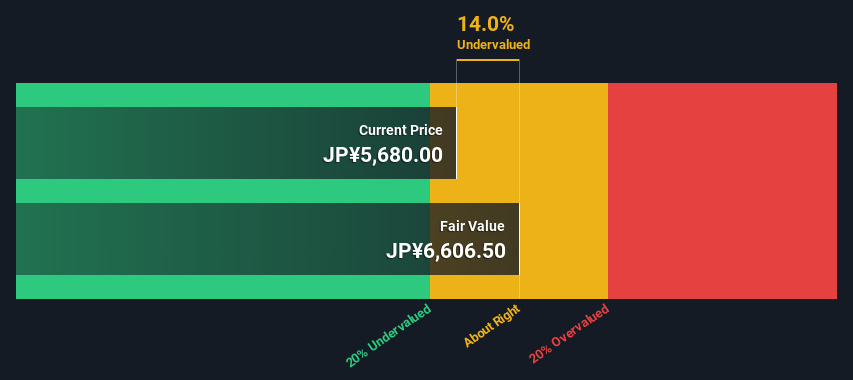- Japan
- /
- Retail Distributors
- /
- TSE:8117
A Look At The Fair Value Of Central Automotive Products Ltd. (TSE:8117)

Key Insights
- Using the 2 Stage Free Cash Flow to Equity, Central Automotive Products fair value estimate is JP¥6,606
- Current share price of JP¥5,680 suggests Central Automotive Products is potentially trading close to its fair value
- Industry average discount to fair value of 10% suggests Central Automotive Products' peers are currently trading at a lower discount
How far off is Central Automotive Products Ltd. (TSE:8117) from its intrinsic value? Using the most recent financial data, we'll take a look at whether the stock is fairly priced by projecting its future cash flows and then discounting them to today's value. Our analysis will employ the Discounted Cash Flow (DCF) model. There's really not all that much to it, even though it might appear quite complex.
Companies can be valued in a lot of ways, so we would point out that a DCF is not perfect for every situation. If you still have some burning questions about this type of valuation, take a look at the Simply Wall St analysis model.
See our latest analysis for Central Automotive Products
The Method
We're using the 2-stage growth model, which simply means we take in account two stages of company's growth. In the initial period the company may have a higher growth rate and the second stage is usually assumed to have a stable growth rate. In the first stage we need to estimate the cash flows to the business over the next ten years. Seeing as no analyst estimates of free cash flow are available to us, we have extrapolate the previous free cash flow (FCF) from the company's last reported value. We assume companies with shrinking free cash flow will slow their rate of shrinkage, and that companies with growing free cash flow will see their growth rate slow, over this period. We do this to reflect that growth tends to slow more in the early years than it does in later years.
Generally we assume that a dollar today is more valuable than a dollar in the future, so we need to discount the sum of these future cash flows to arrive at a present value estimate:
10-year free cash flow (FCF) forecast
| 2024 | 2025 | 2026 | 2027 | 2028 | 2029 | 2030 | 2031 | 2032 | 2033 | |
| Levered FCF (¥, Millions) | JP¥5.95b | JP¥6.08b | JP¥6.19b | JP¥6.26b | JP¥6.32b | JP¥6.36b | JP¥6.39b | JP¥6.42b | JP¥6.44b | JP¥6.46b |
| Growth Rate Estimate Source | Est @ 3.24% | Est @ 2.32% | Est @ 1.67% | Est @ 1.22% | Est @ 0.90% | Est @ 0.68% | Est @ 0.52% | Est @ 0.41% | Est @ 0.34% | Est @ 0.28% |
| Present Value (¥, Millions) Discounted @ 5.4% | JP¥5.6k | JP¥5.5k | JP¥5.3k | JP¥5.1k | JP¥4.9k | JP¥4.7k | JP¥4.4k | JP¥4.2k | JP¥4.0k | JP¥3.8k |
("Est" = FCF growth rate estimated by Simply Wall St)
Present Value of 10-year Cash Flow (PVCF) = JP¥48b
After calculating the present value of future cash flows in the initial 10-year period, we need to calculate the Terminal Value, which accounts for all future cash flows beyond the first stage. The Gordon Growth formula is used to calculate Terminal Value at a future annual growth rate equal to the 5-year average of the 10-year government bond yield of 0.2%. We discount the terminal cash flows to today's value at a cost of equity of 5.4%.
Terminal Value (TV)= FCF2033 × (1 + g) ÷ (r – g) = JP¥6.5b× (1 + 0.2%) ÷ (5.4%– 0.2%) = JP¥125b
Present Value of Terminal Value (PVTV)= TV / (1 + r)10= JP¥125b÷ ( 1 + 5.4%)10= JP¥74b
The total value, or equity value, is then the sum of the present value of the future cash flows, which in this case is JP¥122b. The last step is to then divide the equity value by the number of shares outstanding. Compared to the current share price of JP¥5.7k, the company appears about fair value at a 14% discount to where the stock price trades currently. The assumptions in any calculation have a big impact on the valuation, so it is better to view this as a rough estimate, not precise down to the last cent.

The Assumptions
The calculation above is very dependent on two assumptions. The first is the discount rate and the other is the cash flows. You don't have to agree with these inputs, I recommend redoing the calculations yourself and playing with them. The DCF also does not consider the possible cyclicality of an industry, or a company's future capital requirements, so it does not give a full picture of a company's potential performance. Given that we are looking at Central Automotive Products as potential shareholders, the cost of equity is used as the discount rate, rather than the cost of capital (or weighted average cost of capital, WACC) which accounts for debt. In this calculation we've used 5.4%, which is based on a levered beta of 0.922. Beta is a measure of a stock's volatility, compared to the market as a whole. We get our beta from the industry average beta of globally comparable companies, with an imposed limit between 0.8 and 2.0, which is a reasonable range for a stable business.
SWOT Analysis for Central Automotive Products
- Earnings growth over the past year exceeded the industry.
- Currently debt free.
- Dividends are covered by earnings and cash flows.
- Dividend is low compared to the top 25% of dividend payers in the Retail Distributors market.
- Annual revenue is forecast to grow faster than the Japanese market.
- Good value based on P/E ratio and estimated fair value.
- No apparent threats visible for 8117.
Next Steps:
Although the valuation of a company is important, it is only one of many factors that you need to assess for a company. The DCF model is not a perfect stock valuation tool. Rather it should be seen as a guide to "what assumptions need to be true for this stock to be under/overvalued?" For example, changes in the company's cost of equity or the risk free rate can significantly impact the valuation. For Central Automotive Products, there are three further elements you should look at:
- Risks: Every company has them, and we've spotted 1 warning sign for Central Automotive Products you should know about.
- Future Earnings: How does 8117's growth rate compare to its peers and the wider market? Dig deeper into the analyst consensus number for the upcoming years by interacting with our free analyst growth expectation chart.
- Other High Quality Alternatives: Do you like a good all-rounder? Explore our interactive list of high quality stocks to get an idea of what else is out there you may be missing!
PS. Simply Wall St updates its DCF calculation for every Japanese stock every day, so if you want to find the intrinsic value of any other stock just search here.
New: AI Stock Screener & Alerts
Our new AI Stock Screener scans the market every day to uncover opportunities.
• Dividend Powerhouses (3%+ Yield)
• Undervalued Small Caps with Insider Buying
• High growth Tech and AI Companies
Or build your own from over 50 metrics.
Have feedback on this article? Concerned about the content? Get in touch with us directly. Alternatively, email editorial-team (at) simplywallst.com.
This article by Simply Wall St is general in nature. We provide commentary based on historical data and analyst forecasts only using an unbiased methodology and our articles are not intended to be financial advice. It does not constitute a recommendation to buy or sell any stock, and does not take account of your objectives, or your financial situation. We aim to bring you long-term focused analysis driven by fundamental data. Note that our analysis may not factor in the latest price-sensitive company announcements or qualitative material. Simply Wall St has no position in any stocks mentioned.
About TSE:8117
Central Automotive Products
Engages in the import, export, and wholesale of automotive parts and accessories.
Flawless balance sheet established dividend payer.
Market Insights
Community Narratives



